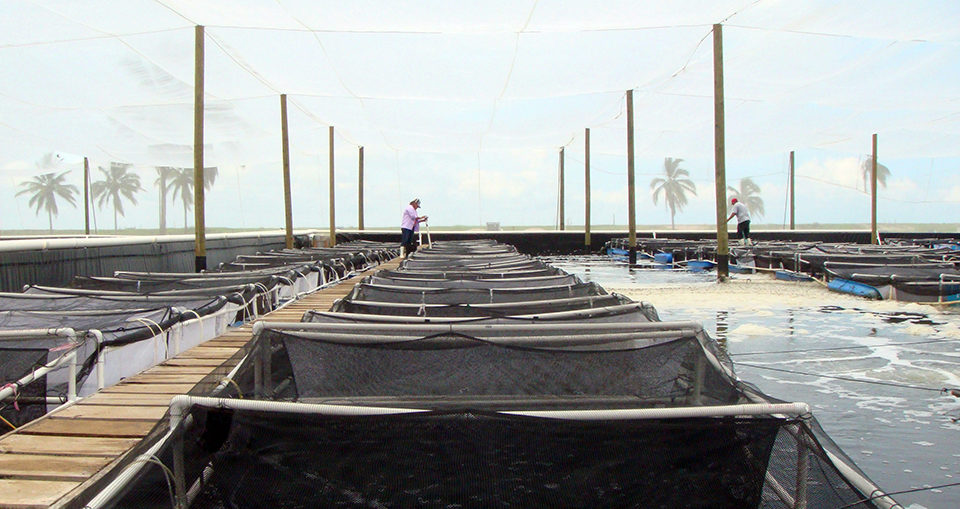Nauplii and PL productions rely on reproductive efficacy of commercial lines

Increasing economic efficiency in aquaculture production systems relies on continuous improvement and the use of breeding programs. This is why most large shrimp hatcheries develop breeding programs oriented to increase growth traits, survival and/or disease resistance. However, in the long run, these programs increase inbreeding in the genetic nucleus populations of these hatcheries.
Inbreeding causes a reduction in genetic variation, compromises responses to selection in future generations and can end up depressing animal growth, survival and reproductive performance. Given the high shrimp prolificacy, breeding programs usually include a rather limited number of selected progenitors, which increases the likelihood of mating related animals.
Maricultura del Pacífico
The breeding program at Maricultura del Pacífico, the largest shrimp hatchery in Mexico, is designed to increase growth and survival, and is based on a two-stage selection program. The first stage is based on growth at 28 days of age and starts with 300 families. The second stage starts with the best 150 families and considers a selection index for growth at 130 days of age and survival from 70 to 130 days of age in four different growth environment ponds. The breeding program keeps strict control on the pedigree of every animal, which helps keep inbreeding in the genetic nucleus population at a minimum.
The hatchery started operations in 1998, and by 2009, its pedigree included 2,485 progenitors and more than 175,000 animals. In 2009, the inbreeding in the nucleus population was estimated as 3.1 percent. Maricultura del Pacífico also has a conservation line separated from the first one. This line is under selection as well, but its main objective is to serve as a future source of genetic variation.
The animal-breeding team is also doing applied research to improve and evaluate the breeding program in the hatchery. Studies are examining the use of genetic markers for parental assignation and to evaluate genetic changes associated with the breeding program. The potential effects of high inbreeding levels are under study, too, as well as ways to improve the current artificial insemination practices.
Inbreeding results
One of the research lines is being used to study the effects of inbreeding on growth, survival and reproduction. An experiment was performed to compare 16 high-inbred families with an inbreeding coefficient ranging from 25 to 33 percent against a control group of 70 families with an average inbreeding coefficient of 1.5 percent.
Preliminary results showed no adverse effects of inbreeding on body weight at 130 days of age, survival from 70 to 130 days of age and the number of eggs per spawn. However, the fertilization rate and number of nauplii yielded per high-inbred female were lower than those observed in the control line (Table 1).
Campos-Montes, Performance of inbred and non-inbred Pacific white shrimp, Table 1
| Group | Body Weight (g, 130 days) | Survival (%, 70-130 days) | Number of Eggs (1,000) | Number of Nauplii (1,000) | Fertilization (%) |
|---|
Group | Body Weight (g, 130 days) | Survival (%, 70-130 days) | Number of Eggs (1,000) | Number of Nauplii (1,000) | Fertilization (%) |
|---|---|---|---|---|---|
| Inbred | 16.8 ± 2.8a | 72.8 ± 10.1a | 186.5 ± 91.0a | 17.0 ± 27.4a | 27.4 ± 14.9a |
| Control | 16.3 ± 3.3a | 69.4 ± 11.4a | 193.2 ± 69.6a | 43.0 ± 72.7b | 72.7 ± 32.5b |
Although growth and survival did not seem to be affected within the range of the studied inbreeding levels, it is noteworthy that the shrimp under study grew only under one set of environmental condition. In the next stages of this experiment, inbred animals will be grown and evaluated under several of Mexico’s typical commercial farm conditions.

Although the negative effect observed on the reproductive traits does not affect shrimp farms in a direct manner, the fertility reduction observed in the inbreeding families is very important to shrimp hatcheries. The shrimp industry must be aware of the inbreeding consequences on reproductive traits, since their nauplii and postlarvae productions rely on the reproductive efficacy of their commercial lines.
(Editor’s Note: This article was originally published in the January/February 2011 print edition of the Global Aquaculture Advocate.)
Authors
-
Dr. Gabriel R. Campos-Montes
Maricultura del Pacífico S.A. de C.V.
Mazatlán, Sinaloa, México -
Dr. Héctor Castillo-Juárez
Universidad Autónoma Metropolitana – Xochimilco
México City, Mexico -
Dr. Hugo H. Montaldo
Universidad Nacional Autónoma de México
México City, México
Tagged With
Related Posts

Health & Welfare
Inbreeding cuts growth, reproduction in shrimp
Shrimp-breeding programs release only a small fraction of their genetic material when they sell seed to clients for grow-out. This protects their large investment in developing the stocks so clients return for their next batch of seed instead of breeding the stocks themselves.

Health & Welfare
10 paths to low productivity and profitability with tilapia in sub-Saharan Africa
Tilapia culture in sub-Saharan Africa suffers from low productivity and profitability. A comprehensive management approach is needed to address the root causes.

Health & Welfare
‘Big picture’ connects shrimp disease, inbreeding
Disease problems on shrimp farms may be partly driven by an interaction between management practices that cause inbreeding in small hatcheries and the amplification by inbreeding of susceptibility to disease and environmental stresses.

Intelligence
A motive, and a market, for farmed fish in Mexico
Boasting ample areas for aquaculture and a robust domestic demand for seafood – not to mention its close proximity to the U.S. market – a land of opportunity lies in Mexico. Fish farming is primed to meet its potential south of the border.


